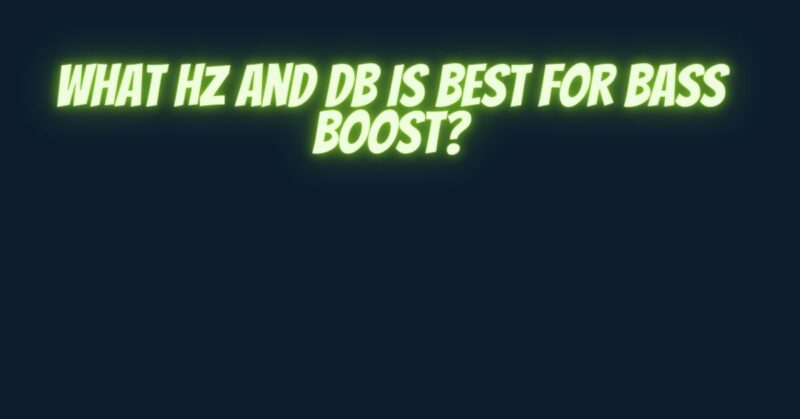Bass is a fundamental element of audio that can significantly enhance your listening experience, whether you’re a music enthusiast or an audiophile. If you’re wondering about the ideal settings for bass boost in terms of Hertz (Hz) and decibels (dB), you’ve come to the right place. In this article, we’ll explore the factors that influence the perfect Hz and dB settings for bass boost, helping you achieve a rich and immersive bass experience tailored to your preferences.
Understanding Bass Boost Settings
Bass boost settings allow you to enhance the low-frequency response in your audio system, emphasizing the deep bass tones that add depth and impact to music and other audio content. These settings are commonly found in equalizers (EQs), amplifiers, and audio playback software.
Factors Influencing the Best Hz and dB Settings
To determine the ideal Hz and dB settings for bass boost, consider the following factors:
- Content Type: The type of audio content you’re listening to plays a crucial role. Different genres of music and audio content have varying bass characteristics. Genres like hip-hop, EDM, and dubstep are known for their heavy bass, while classical music may require a subtler approach.
- Listening Environment: The size and acoustics of your listening environment can impact your perception of bass. Smaller rooms may amplify bass frequencies, making them feel more pronounced, while larger spaces may require higher dB settings to maintain impact.
- Equipment Quality: The quality and capabilities of your audio equipment, including speakers and subwoofers, play a significant role. High-quality equipment can handle bass boost settings more effectively, providing a cleaner and more controlled bass response.
- Personal Preferences: Your own listening preferences are crucial. Some listeners prefer a pronounced and powerful bass presence, while others favor a more balanced or neutral sound profile.
Determining the Best Hz and dB Settings
- Start with Flat EQ: Begin by setting your EQ or bass boost settings to a flat or neutral position. This ensures that you’re starting from a balanced audio baseline.
- Reference Material: Use well-recorded reference tracks that you are familiar with. These tracks should encompass a range of music genres and audio content to help you evaluate the impact of bass settings accurately.
- Gradual Adjustment: Gradually increase the bass boost settings in small increments. Start by adjusting the dB settings, typically in increments of 1dB to 3dB, and then focus on the Hz settings.
- Listening Tests: Pay close attention to how each adjustment affects your listening experience. Listen for changes in the depth of bass, the impact on vocals and midrange, and the overall audio balance.
- Distortion Check: Be cautious of distortion. If you hear buzzing, rattling, or any form of audio distortion, you’ve likely exceeded the capabilities of your equipment or room. Reduce the bass boost settings to eliminate distortion.
- Room Acoustics: Take room acoustics into account, as they can influence how bass frequencies are perceived. Experiment with bass settings while considering the room’s size, shape, and furnishings.
- Personalization: Ultimately, the best Hz and dB settings for bass boost are those that align with your listening preferences. Trust your ears and prioritize the sound profile that delivers the most enjoyable and satisfying audio experience for you.
The ideal Hz and dB settings for bass boost are subjective and personalized, influenced by content type, listening environment, equipment quality, and personal preferences. The goal is to strike the perfect balance between enhanced bass impact and overall audio quality. By gradually adjusting bass boost settings, listening attentively, and considering your specific context, you can create a customized sound profile that brings depth and excitement to your music and audio content without sacrificing audio fidelity or introducing distortion.


